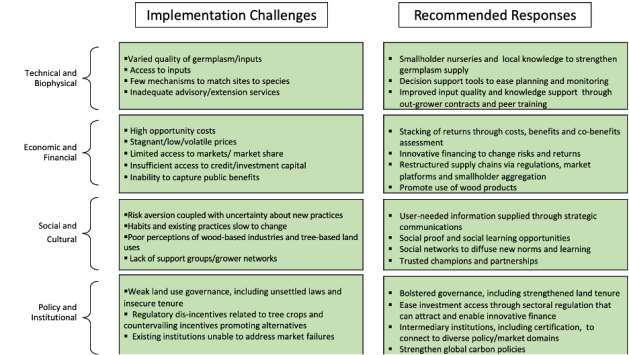Tree cover restoration provides an opportunity to combine climate change mitigation with the pursuit of other sustainable development goals. Unfortunately, most forest restoration studies at global or tropical scales have not distinguished and evaluated the potential importance of restoration by small land holders.
The Gist
Restoring tree cover in tropical countries could impact millions of small land holders (called “smallholders”) through improvements in income and environmental services. However, despite their dominant landholding shares in many countries, smallholders’ role in restoration has not been addressed in prior global or pan-tropical restoration studies.
This study, “Scaling smallholder tree cover restoration across the tropics,” published in Global Environmental Change fills a glaring gap in knowledge. The science shows that when it comes to mitigating climate change, the scale of solutions matters. And when it comes to tropical forest restoration at scale, smallholders—especially in the tropics—matter. A lot.
The Big Picture
According to the study, while much is known about what motivates investments in tree planting by institutional investors, corporations and governments, and the factors that influence tree planting by individual smallholders, the combination of conditions necessary to achieve large increases in smallholder tree planting is poorly understood.
This gap in the literature is all the more important because 94% of farms (572 million) globally that support crop and livestock production have landholdings that are 5 hectares or smaller, accounting for 18% of farmland. Smallholdings (5 ha or less) are a particularly significant component of the landscape in low- and lower middle-income countries (LLMICs), accounting for approximately 72 % and 60 % of farmland, respectively.
“Our paper,” notes lead author Priya Shyamsundar, TNC’s Lead Economist, “was motivated by the need to understand the people and policy dimensions of tree cover restoration as a natural solution to climate change and by the recognition that 94% of farmers globally are smallholders—so without partnering with them, agroforestry and restoration are unlikely to happen at scale.”

In countries with low-cost tropical restoration potential, smallholdings comprise a significant proportion of agricultural lands in Asia (~76 %) and Africa (~60 %) but not the Americas (~3%). Thus, while the Americas account for approximately half of 21st century tropical deforestation, smallholder-based reforestation may play a larger role in efforts to reverse recent forest loss in Asia and Africa than in the Americas.
The Takeaway
The key point the analyses shows is that countries with low-cost restoration potential largely lack policy commitments or smallholder supportive institutional and market conditions. Discussions among practitioners and researchers suggest that four principles could enable smallholder tree cover restoration projects at scale.
- Principle No. 1: Partner with farmers and prioritize their preferences, building on social norms, and addressing capacity needs. This will require upfront engagement with smallholders, building trusted partnerships and prioritizing smallholder preferences where there are differences between global restoration and smallholder goals.
- Principle No. 2: Reduce uncertainty regarding inputs and outputs associated with tree planting. A set of lookup tables on appropriate species, tree survival and carbon accumulation rates, management practices, carbon prices, indicators on ease of forestry business, and land and tree rights would reduce the transaction costs of reforestation investments,
- Principle No. 3: Strengthen market transactions. Policy reforms that increase revenues from tree products and make market transactions less costly and more widespread are essential.
- Principle No. 4: Mobilize innovative financing to expand access to funds and reduce transaction costs — accepting varied forms of collateral and offering new insurance products or loans with longer payback periods to allow for tree growth.

“Our study is about a framework for implementation, for analyzing the steps necessary to scale smallholder tree cover restoration across the tropics,” says Shyamsundar. “It brings together scientists and practitioners to spatially identify the people who are likely to be affected by restoration, clarify policy constraints, explore solutions, and offer principles for moving forward.”



